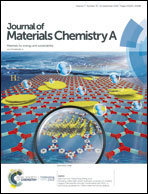An interfacial polymerization strategy towards high-performance flexible supercapacitors†
Abstract
Flexible supercapacitors with high power densities are of great interest for wearable electronics due to accommodation of large strains without remarkable loss in energy storage and cycling life. However, their performances under flexible conditions degrade significantly because of the unstable interface between electrode and electrolyte layers, which plays a key role in exchange of energy and materials in the devices. Here, we report an interfacial polymerization strategy for fabricating a robust interface in the device with the aim of improving the mechanical properties and energy storage stabilities in flexible environments. The as-fabricated supercapacitor with poly(3,4-ethylenedioxythiophene) and thermal polyurethane/1-ethyl-3-methylimidazolium bis(trifluoromethylsulfonyl)imide as the electrode and electrolyte layers exhibited a specific capacitance of 130 F g−1 at the current density of 1 A g−1 with excellent stability over 20 000 cycles. Moreover, the flexible device was found to give stable capacitance during charge–discharge cycles under twisted and bending conditions over more than 2500 cycles, which was significantly higher than that for the device with the same structure and materials made from the conventional assembly method.



 Please wait while we load your content...
Please wait while we load your content...